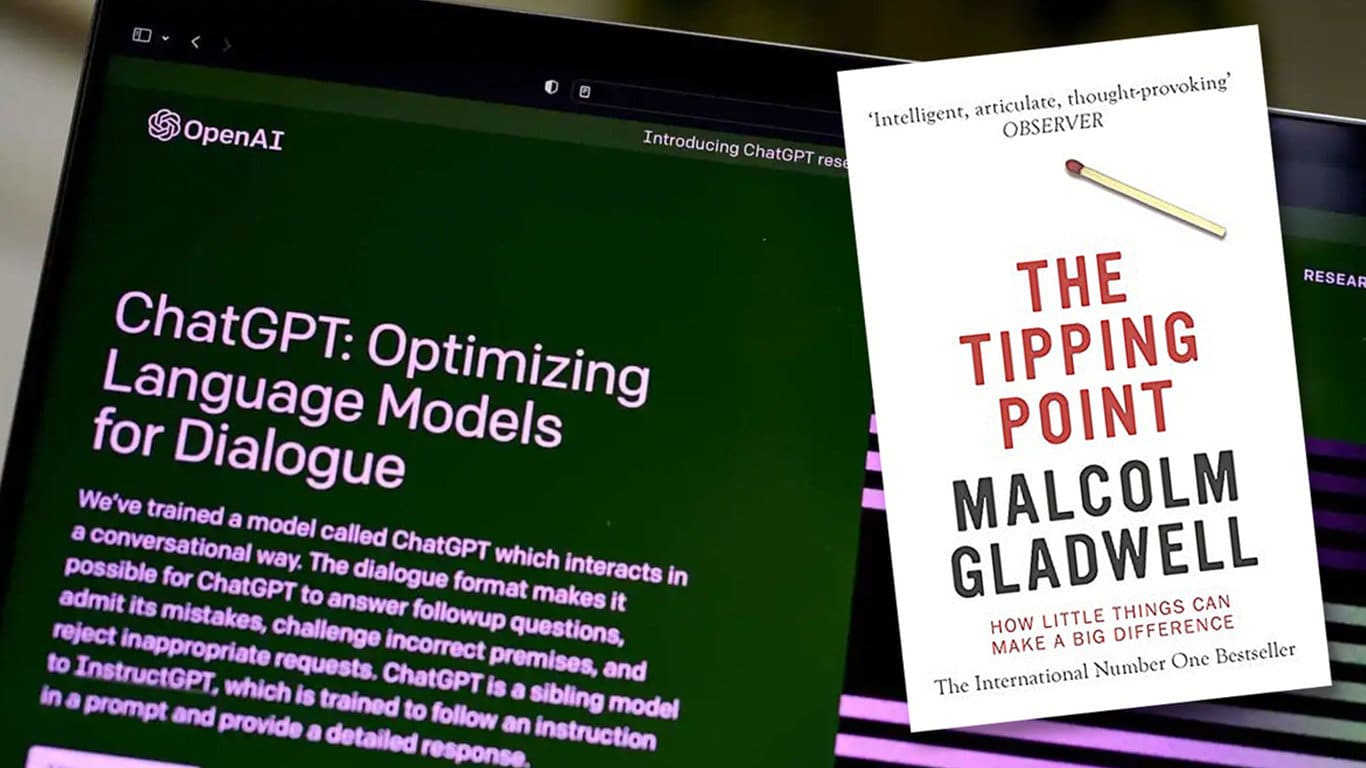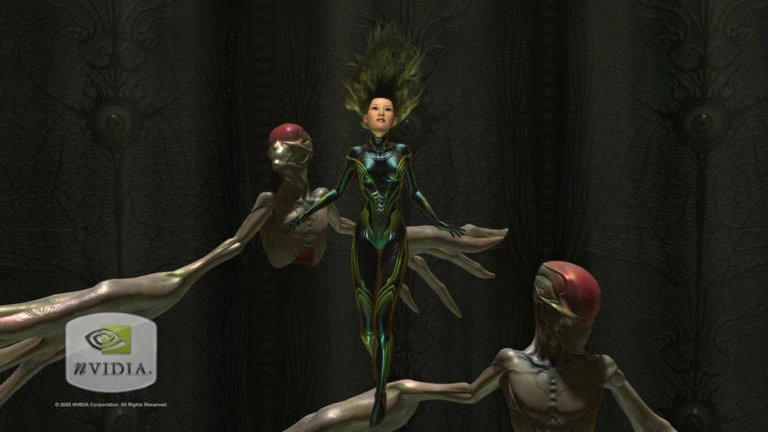A Visualization of Malcolm Gladwell’s Writing Style Using AI
For the past few years, I’ve been pouring my heart and soul into writing a book. As I neared the finish line and prepared for the whirlwind of publication, a nagging feeling hit me. My manuscript seemed to lack a vital ingredient – a magical flow and seamless connection between narratives, case studies, and topics. The kind of ‘magic’ I’d found in the works of renowned literary giants like Malcolm Gladwell, Simon Sinek, and Jim Collins.
Being a novice writer, I’ve grappled with channeling that same mesmerizing quality into my writing. I firmly believe that, like any skill, this magical touch will become more intuitive with experience. But as a greenhorn, experience isn’t something I have in abundance. This led me to ponder: could a more analytical look at the data provide me with some insight? Could a visualization of Malcolm Gladwell’s Writing Style unearth patterns or techniques that could guide my writing style?
How we used ChatGPT AI to analyze and segment Malcolm Gladwell’s Writing Style
Using Malcolm Gladwell’s Tipping Point as my reference of his writing style, I decided to zero in on the introduction and the first chapter for my exploratory study. Why? Because, in my view, these are the sections that make or break a book, whether displayed on Amazon or nestled among hundreds of other hopefuls on a bookstore shelf.
The introduction and the first chapter are the grand openings of your literary show. They set the stage for everything that follows. They need to be compelling, offer a tantalizing glimpse into the book’s core idea, and possess an element of relatability that forges a personal connection with the reader. This connection tempts them to turn the page and embark on the journey you’ve laid out.
In an endeavor to deconstruct the creative genius of Malcolm Gladwell, I embarked on an interesting experiment. I transcribed the introduction and first chapter of Gladwell’s book in its entirety and turned to ChatGPT to unpack the text into unique topics and measure the length of those topics in words.
ChatGPT Prompt: Based on the following article, please analyze and identify in bullet points each unique case study or topic and the number of words for that unique case study or topic. Create a list ordered by when the topic occurred. the goal is to identify when a unique topic was mentioned and how much time was spent on that topic to create a framework for organizing the presentation of a narrative story.
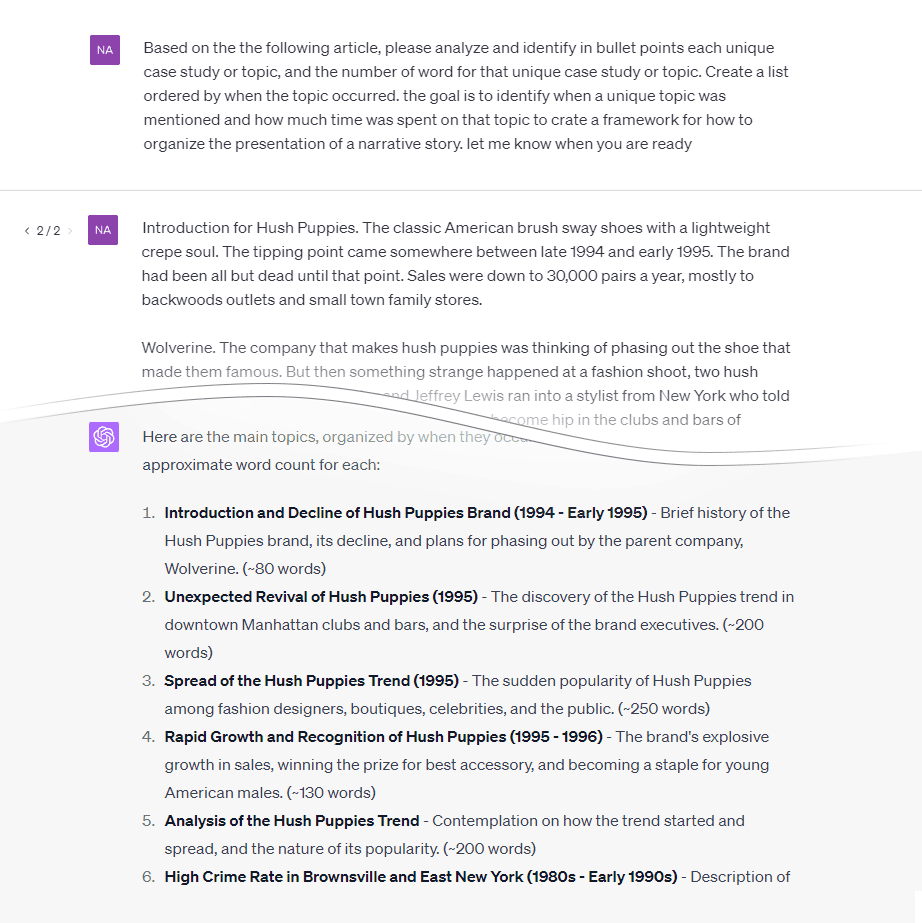
ChatGPT offered me a detailed breakdown of the major topics and their lengths. While it wasn’t 100% accurate (for instance, in instances where paragraphs overarching the book’s primary objectives often referred to previous and hinted towards future case studies), the analysis was surprisingly close compared to the original text.
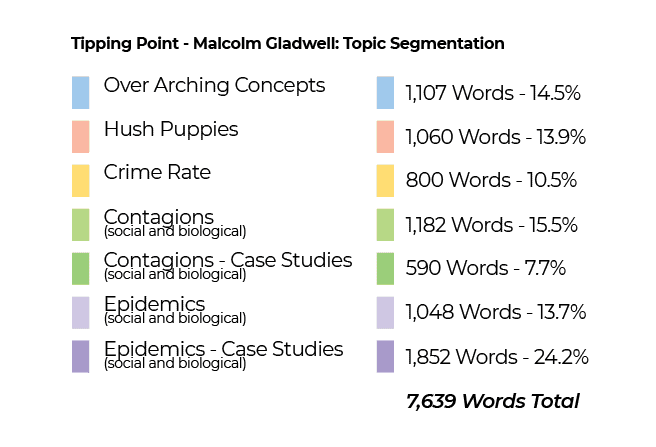
The analysis of the writing style was bifurcated into a handful of key topics, which are listed in the legend above. To make the data visually comprehensible, I used color to distinguish each topic. Topics of variations of the same concept utilized shades of the same color. This allowed me to easily distinguish sections that were different but connected to the same overarching themes.
My first step was to employ color coding to a vertically stacked bar graph representing the length of the topic based on word count. I also included a brief description of each topic and its word length. While this was a good beginning, I couldn’t completely visualize it at a glance since the data couldn’t neatly fit into a single vertical column. This led me to create alternative visualizations.
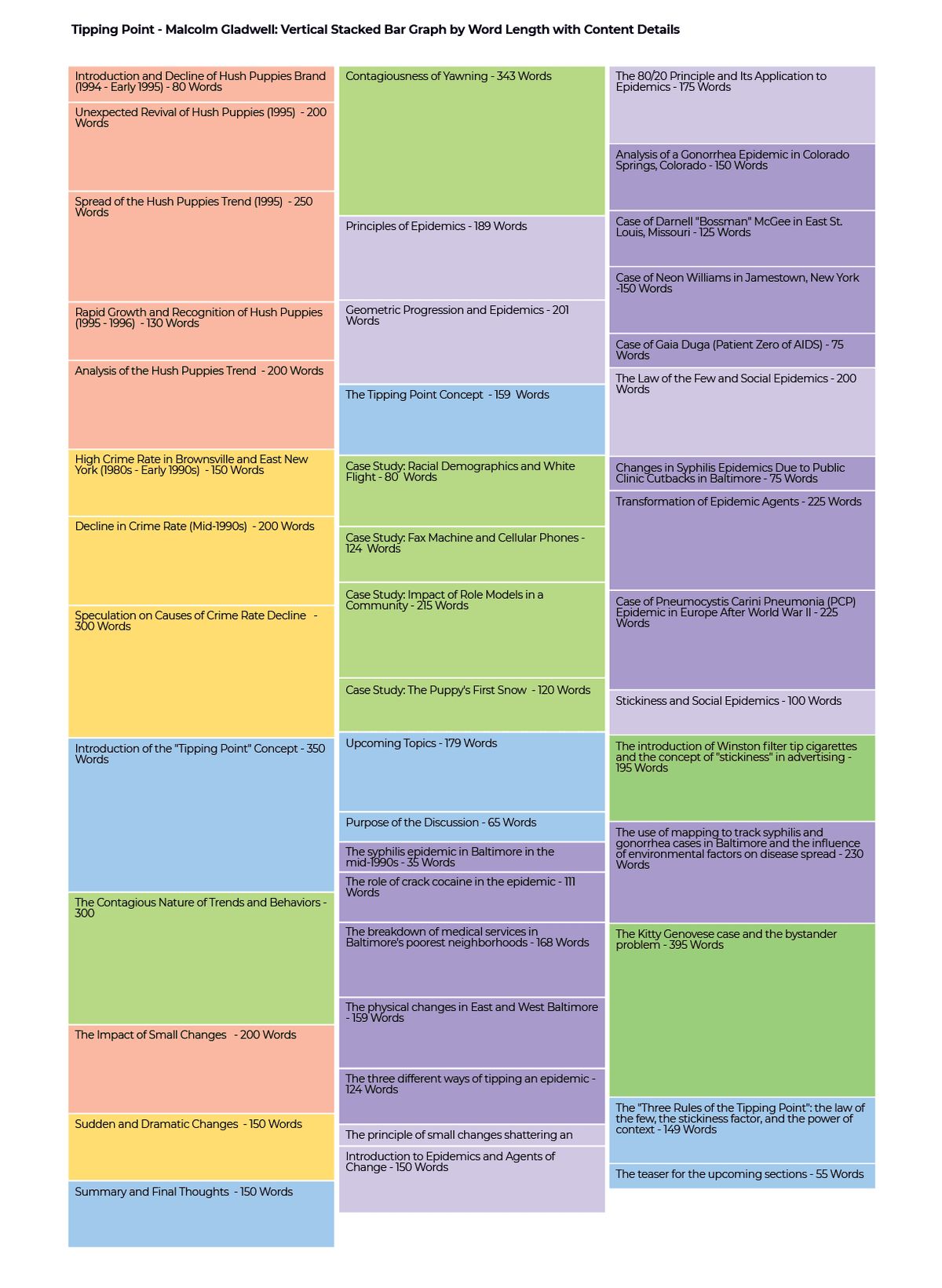
The following two views are horizontal alternatives that compress the information into a more visual representation, relying primarily on color to emphasize the weight of topics. These alternative views offered a much clearer visualization of the information, making it easier to digest and interpret.
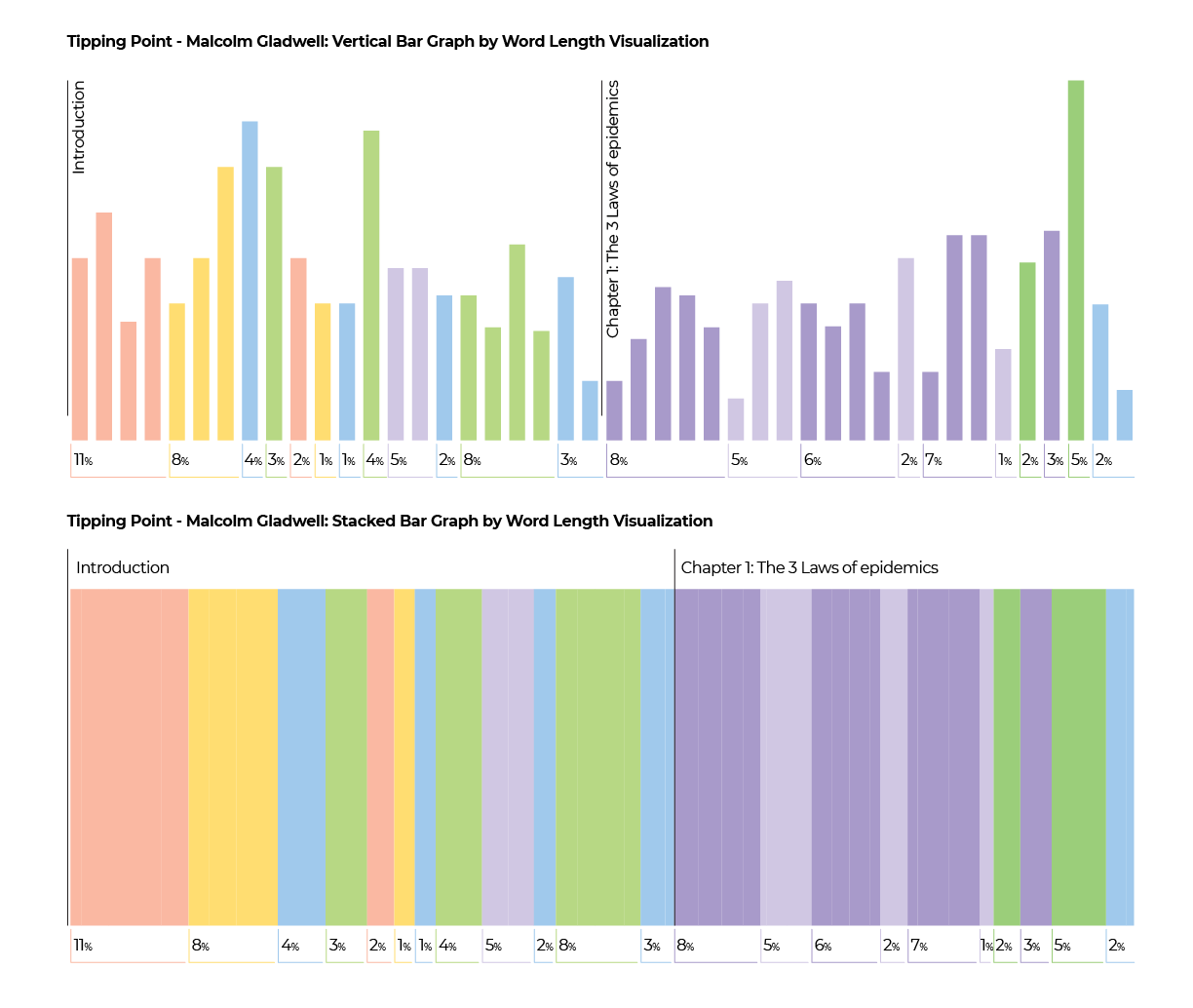
This gave me a much clearer visualization of the information, making it easier to digest and interpret. Here are some of my initial assumptions at a glance.
Introduction
- Opens with an intro to the Hush Puppies story (hints to a pattern emerging)
- Continues with an intro to the Crime Rates story (hints to a pattern emerging)
- Overarching concept, “What is a tipping point?”
- Introduction to Contagions (what are they, how they work)
- Asks, “Are both Hush Puppies and Crime Rates an example of contagion? Hint to how both cases ended.
- Summarizes how the spread of contagions is correlated to Tipping Points
- Example of contagious behavior in an everyday relatable example (not as extreme as a disease but in social behavior)
- Introduction to Epidemics (what are they, how they work) and Hush Puppies and Crime Rate could be related epidemics.
- Expand on how Epidemics (how it spreads and grows)
- Summarizes how the spread of epidemics is correlated to Tipping Points
- Case studies of Contagions (4 very distinct examples)
- Overview of upcoming topics and questions to ask.
Chapter 1
- Epidemic Case Studies (3 examples of health) Note: Baltimore Case 1 to Crack to Baltimore Case 2, Baltimore Case 3.
- Expands on the general topic of Epidemics
- Back to Baltimore Epidemic Case Studies
- Expands on the Epidemics and their Correlation to Case Studies
- New Contagion case study
- Baltimore case study from both contagion and epidemic views
- New Contagion case study
- Recap of how all three key topics (Hush Puppies, Crime Rate, Disease) had key Tipping Points that allowed them to spread and grow.
From this analysis, I could discern key flow patterns. Gladwell writing style typically begins with a few case studies that weave a narrative story, hinting at an emerging pattern. Whether it’s the rise in popularity of Hush Puppies or the escalating crime rates in Brownsville and New York, Gladwell provides just enough detail to pique interest without diving into the ‘how.’ He then transitions to the point of the book, asking ‘how did this happen?’ The pattern is the following:
- An introduction to the case study from a third-person account but includes vivid details that allow the reader to feel as if they are there.
- Follow with a short mention of how it ended up, stating just the facts. It became popular, and it disappeared, it changed unexpectedly, and so on.
- It’s the beginning and the end with no mention of the middle. I’d like to look at it as “When” and “What,” excluding “How.”
- The next part of the narrative introduces another topic that ties the initial case studies together, suggesting they’re not independent occurrences but the products of a common underlying theme.
- The introduction concludes with a grand overview of how the different case studies and topics interconnect and a preview of what’s to come inviting you to continue reading to see the “How.”
- Chapter One marks a shift in the narrative as Gladwell begins to delve deeply into a specific topic, alternating between large chunks of understanding of the topic and comprehensive case studies.
- One key takeaway from the end of the chapter is the question – are the case studies related to epidemics, contagions, or both? He then ties it back to the overarching theme of the book and its relation to the initial case studies.
While it’s challenging to determine whether this analysis will help me improve the flow and pacing of my writing, it certainly offers a promising starting point. Following Gladwell’s seemingly complex but remarkably digestible and easy-to-process structure may just be the key to creating engaging narratives.
Remember that this is a high-level interpretation of his writing style and by no means something definitive. It merely serves two things, the value of ChatGPT for analyzing data and the value of visualization to interpret large data sets.

